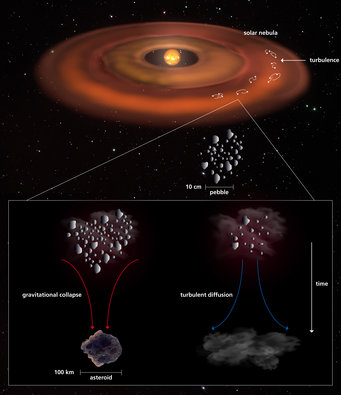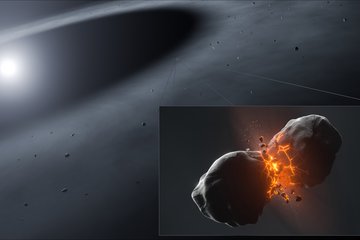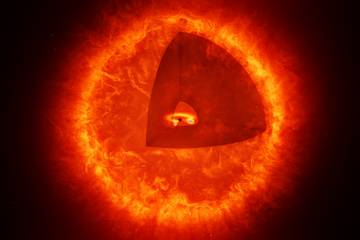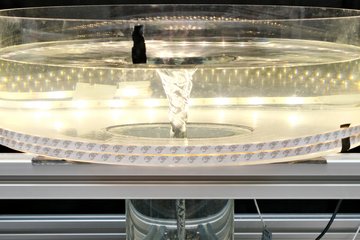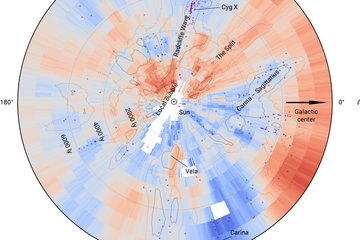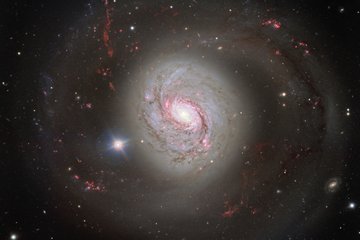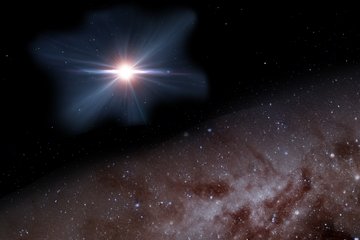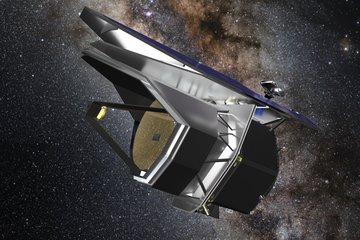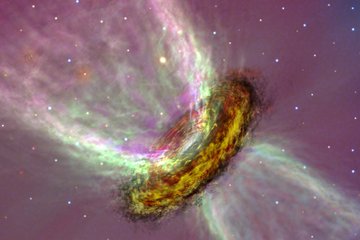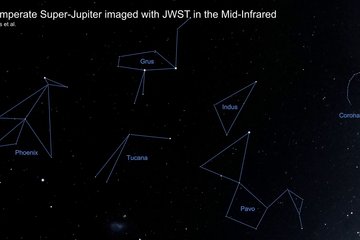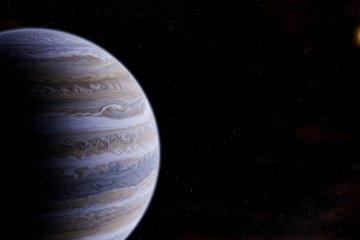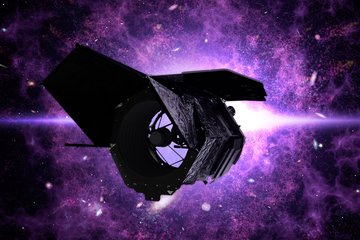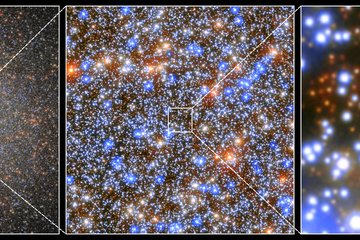Asteroids are born big – and here is why!
Why do asteroids in the solar system have the sizes we observe? Two researchers at the Max Planck Institute for Astronomy have found an answer to that fundamental question: For the birth planets and planet precursors in our solar system 4.5 billion years ago, turbulence played a key role, helping to bring together pebble-like objects to form larger aggregations known as planetesimals. The presence of turbulence also sets a minimal mass and thus a minimal size for the resulting objects. From this model, the two researchers can predict the size distribution of the remaining objects of this type in the present solar system, namely the asteroids.
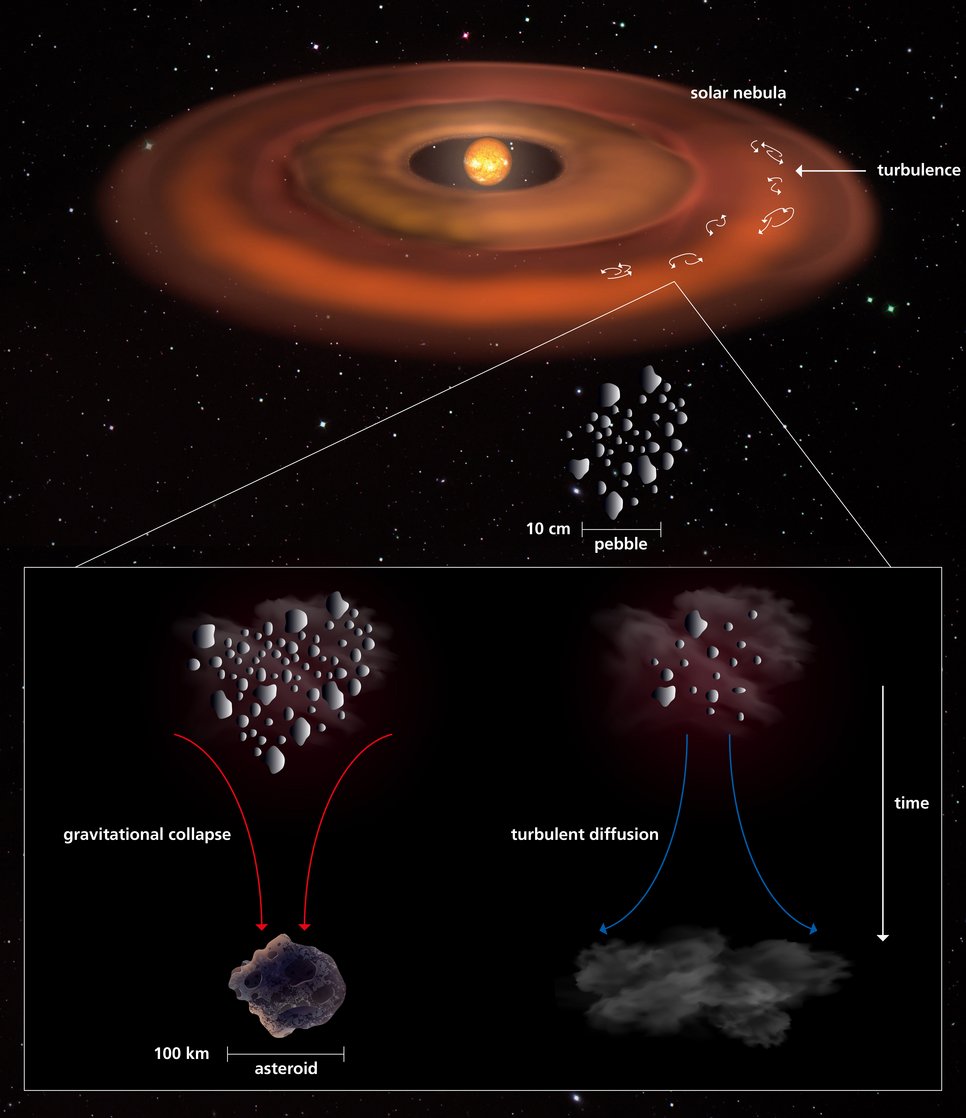
In a way, the asteroid belt between Mars and Jupiter and the Edgeworth-Kuyper belt beyond the orbit of Neptune are like cosmic museums: Both contain small bodies that represent an intermediate state of planet formation within our solar system. Now, astronomers at the Max Planck Institute for Astronomy have been able to show how fundamental physics determined the size of the original asteroids – a fundamental length scale within the early solar system. The result rewrites a chapter of planet formation around the Sun, makes specific predictions that could be tested by space probes in the outer solar systems, and is set to give astronomers key information as they interpret the diversity of exoplanets.
An ancient length-scale mystery
Both asteroids and comets are what remains of so-called planetesimals: Solid objects, large enough to be bound by their own gravity, that formed roughly 4.5 billion years ago, when the Sun was still surrounded by a disk of gas and dust. Many planetesimals went on to eventually form the current planets. But in the asteroid belt, the gravitational influence of nearby Jupiter kept planetesimals from clumping together, and in the outer solar system, beyond Neptune, planetesimals simply did not encounter each other frequently enough to bond. That is why, in those regions, we still have these objects around, which provide us with a glimpse about what the early solar system looked like. We do not call these objects planetesimals, though – we call them asteroids.
The intervening 4.5 billion years did not, of course, leave the asteroids completely unchanged. While the asteroid belt is much emptier than science fiction movies make it seem, and collisions are rare, collisions did happen over those past billions of years, and each left behind numerous smaller fragments. Those fragments then move on fairly similar orbits, spreading out over time. About a quarter of all known asteroids can be assigned to a family – a group that has originated from the same collision.
By plotting the orbital parameters of known asteroids, astronomers can estimate which of the objects belong to a cloud of fragments. Take the 500-m-sized asteroid 101955 Bennu, which is currently being visited by the NASA space craft OSIRIS-Rex (Kevin Walsh), with the aim of bringing some of its material back to Earth. Bennu is believed to be a fragment of a much larger asteroid, and is possibly a member of the Polana or Eulalia family of asteroids.
But when researchers around Marco Delbo, at the Observatoire de la Côte d'Azur, performed a thorough asteroid family tree analysis in 2017, they were able to pick out 17 asteroids that apparently had not undergone any collision at all, and were still in the same primordial state as they would have been when they were formed.
The primordial asteroids, and thus presumably the original planetesimals, have a very narrow size distribution. Objects with a diameter of around 100 kilometers are by far more common than either larger or smaller objects, following a so-called Gaussian or normal distribution. But why the 100 kilometers? What is special about this scale?
The challenge of forming large clumps
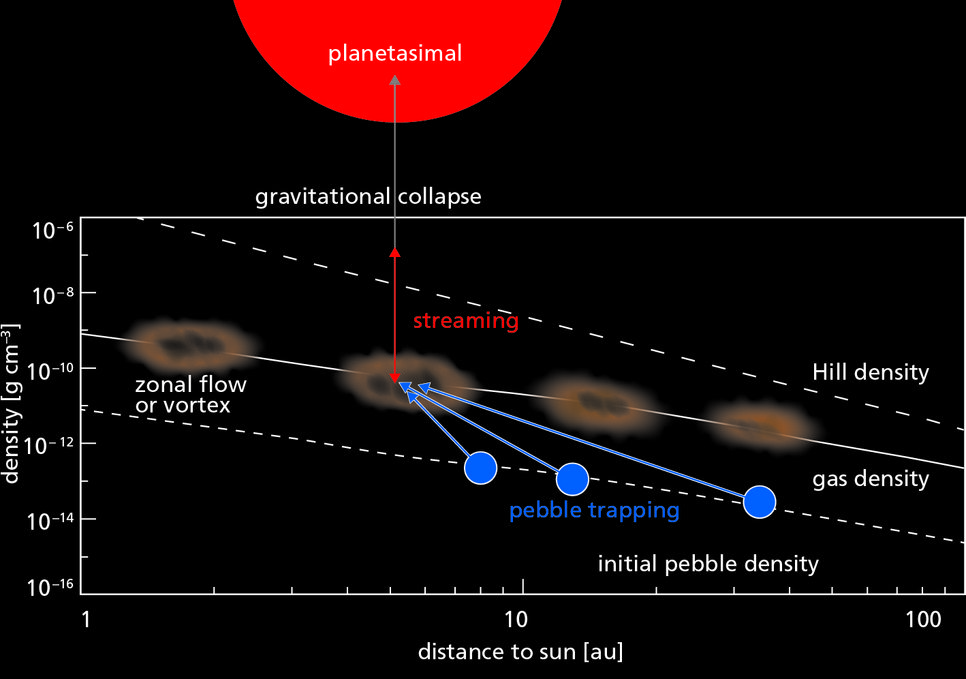
This is where the research by Hubert Klahr comes into play. Klahr is head of the Planet and Star Formation Theory Group at the Max Planck Institute for Astronomy, and he and his colleagues have spent the past decade trying to understand how planets form. Recently, Klahr together with his PhD student and later postdoctoral researcher, Andreas Schreiber, was able to make significant progress – and solve the question of the preferred 100-km scale at the same time.
The broad-brush story of planet formation has been known for a long time. Take a popular astronomy book from the 1970s, and you can read how there was matter left over from the initial disk of gas and dust surrounding the young Sun, and how that matter clumped together to form planets. But the details have long been surprisingly difficult. The dust in the gas disk surrounding a newborn star can indeed clump together to form what astrophysicists have taken to calling pebbles – clumps between a few millimeters and a few centimeters in size.
But the step from there to kilometer-size objects has long been troubling planet-formation researchers. As pebbles grow larger, several things happen: Pebbles become more likely to fracture as they collide, rather than stick together. For a while, researchers had hopes that water ice on pebbles might help them cling together. But that did not turn out all that convincing either, not least because ice at very low temperatures is not all that sticky. Still, a number of researchers in the field still see ice playing a role for the transition from pebbles to larger objects.
Overall, the conventional scenarios continue to have a time-scale problem. Since the surrounding gas rotates at a slower speed than would be needed for a solitary solid object orbiting a star, larger pebbles tend to drift inward, and eventually fall into their star. For slower growth rates, the objects in questions would have ended up inside their stars before they would have reached the necessary size. Only objects larger than about one meter can escape that fatal drift – they become largely independent of the buffeting by the surrounding gas. But how can objects reach that size?
Turbulence to the rescue
For a few years now, Klahr and his colleagues have been on the track of the role of turbulence – chaotic flows within as or another fluid – as a solution to the larger-than-pebbles problem. Observations show that in protoplanetary disks, gas flow is turbulent, with chaotic local variations in gas speed. Without turbulence, dust and pebbles would form a disk as razor-thin as Saturn's rings. But observations show that instead, dust is present throughout the much thicker gas disk that surrounds young stars.
On larger scales, turbulent gas motion in protoplanetary disks can create regions of greatly increased pebble and dust concentrations. Intermittently, such regions can become veritable pebble traps, where pebbles from the surrounding regions become trapped. In such regions, pebbles can accumulate with sufficient total mass for them to be bound together by their mutual gravity – leading to the formation of larger objects on the required much shorter time-scales.
First indications that turbulence plays a key role in planet formation came from numerical simulations and the comparison with detailed observations of the protoplanetary disks around new stars. Simulations by then-MPIA-PhD student Anders Johansen showed that turbulence forces pebbles together, and leads relatively quickly to the formation of planetesimals (see the Nature article Johansen et al. 2007). But simulations are one thing. Klahr and Schreiber set out to gain a deeper understanding – to understand in terms of the underlying physical laws what was happening in those simulations, and presumably around young stars.
The physics behind the turbulent formation of planetary embryos proved surprisingly straightforward – and has fundamental similarities to how stars themselves form: Astronomers have long known that there is a minimum mass for a newborn star. This is due to the fact that the gas clouds that give birth to young stars have internal pressure; in order for gravity to overcome that pressure and pull the gas together into a star, a newly forming star needs to reach a certain mass. This mass is known as the Jeans mass, and depends on the gas density and the temperature.
Klahr and Schneider found a new kind of Jeans mass, for the formation of planetesimals. There, the pressure to be overcome is due not to the gas temperature, but to the turbulent motion of gas and dust.
Setting the scales for planetesimals
This new Jeans mass depends only on the local strength of the turbulence, which in turn depends on how the structure of the gas disk changes as one moves farther away from the central star. If gas pressure drops sufficiently fast with distance, the so-called "streaming instability" will unavoidably produce turbulent motions of the gas and dust. Instead of sinking quietly towards regions of larger pressure, towards the central stars, pebbles move chaotically, stirring the surrounding gas.
For most regions within our Solar System, the turbulent-pressure Jeans mass of a pebble cloud corresponds to planetesimals of a size of around 100 kilometers. Pebble clouds of lower mass are less likely to collapse – they would need a rare chance fluctuation to bring them together all at once. Larger clouds are less likely to form, as clouds should collapse as soon as they exceed the critical mass. Thus, both smaller and larger planetesimals are possible, but naturally much rarer.
This, then, was a suitable candidate for the physics behind the universal Solar-System length scale of primordial asteroid sizes – a limiting mass for the formation of planetesimals.
Klahr's and Schreiber's calculations also make a prediction for remnants of the early planet-formation process in the outer Solar System. Based on what we know from the properties of our Sun's protoplanetary disks, the size of primordial objects which formed in that outer region shrinks to 10 km at a hundred times the Earth-Sun distance. It would be a worthy goal of a future outer system space mission to study how the characteristic size of remnants in the outer solar system so-called Kuiper Belt Objects, decreases with increasing distance from the Sun.
Visits to a planetary museum
Comets visiting us from that outer part of the solar system, the Edgeworth-Kuiper belt, are not likely to be in pristine shape – simulations suggest that they will unavoidably have undergone several collisions since the Solar System came into being. But a direct mission into the Edgeworth-Kuiper Belt, where collisions are less likely, should be able to identify and examine truly pristine and primordial planetesimals.
Such a planetesimal was very briefly visited by the New Horizons mission after its Pluto flyby in early 2019. At the time, the object that has since been called Arrokoth [original designation (486958) 2014 MU69] was 45 times as far from the Sun as the Earth, making it the most distant primordial object ever visited. Arrokoth looks like a snow-man made of two planetesimals stuck together, one with a diameter of 21 kilometers, the other 15 kilometers. Indeed, the object's surface structure and colour hint at direct formation from a single, rotating pebble cloud. This fits the size predictions of the pebble model for planetesimals forming at this particular distance from the Sun.
Another possibility for finding primordial planetesimals are the so-called Trojan asteroids, which were captured during the birth of the Solar System by Jupiter's gravity. Ever since, they have been orbiting the Sun in two groups, one ahead of Jupiter, one behind ("Lagrange points 4 and 5"). NASA's LUCY probe, slated for launch in late 2021, is meant to visit six of those Trojan asteroids as part of a 12-year-mission. Based on previous observations, the Trojans apparently originate from different regions of the early solar system – it's as if LUCY is visiting a museum of planet formation!
Both LUCY and a possible Edgeworth-Kuiper mission could test the prediction of the Klahr-Schreiber scenario for the sizes of primordial Solar System Objects – both for the size distribution itself and for the frequency of binary objects, where two planetesimals have become stuck together.
Understanding planets around other stars
The new prediction for planetesimal sizes also promises considerable impact on our understanding of the diversity of exoplanets – of planets around stars other than the Sun. Perhaps the greatest value that the so-far 4400 and still increasing numbers of known exoplanets have for our understanding of cosmic history is that they provide a statistical sample. Unlike the single case of our Solar System, the many data points for exoplanets allow us to make deductions about the way planets are formed in our galaxy.
If we understand the physics of planet formation, we can predict the probability of planetary systems of different kinds – massive planets, smaller planets, narrower or wider orbits – to form. By comparing the actual distribution of planetary systems of different kinds, we can test our predictions, and in this way find out if our simulations are realistic.
There are a number of ongoing attempts at "population synthesis," that is, at creating ensembles of realistic planetary systems, extracting the frequencies with which certain properties (such as mass ranges, or orbital parameter ranges) occur, and compare the result to observational data. But so far, those attempts needed to put in the spatial and size distribution of planetesimals and planetary embryos "by hand" as an educated guess. The new results by Klahr and Schreiber, on the other hand, allow researchers to deduce the planetesimal size distribution for each simulation run from the results for the developing population of pebbles, combined with the results for the gas pressure. This closes a fundamental gap in the chain of reasoning of population synthesis studies.
Where the mass concentration within the disk is higher, the effect of turbulence in allowing larger structures to form will be greater. As the gas within the disk is depleted – either by falling into the star or being scooped up by what then become gas planets – the capacity for forming larger planetesimals drops. The results can be brought into a form that allows the researchers running population synthesis models to include the birth of planetesimals and planetary embryos in a simplified way, as a function of the gas pressure that is an integral part of the underlying models.
A model with predictive power
All in all, the new results have closed an important gap in our previous knowledge about planet formation. Hubert Klahr says: “The strength of our model lies in its predictive power. Using the model, we can describe when and where planetesimals should form, as well as the sizes of the newborn planetesimals. Given that there are competing models, we will need to convince our colleagues that we have indeed found the underlying physics of planetesimal foundation. That is where testable predictions can help."
Parts of the planet-formation community favor alternative explanations, involving, for instance, the stickiness of ice, or "fluffy aggregates" (fluffy silicate flakes) as intermediate steps. For Klahr and Schreiber, it is pretty clear that while there may well be a role for those mechanisms at smaller scales, but that they have little to contribute when it comes to bringing objects into the 100-km region.
Klahr says: “Even if collisions were to lead to growth up to 100 km without eventually switching to a gravitational collapse, this method would predict too large a number of asteroids smaller than 100 km. It would also fail to describe the high frequency of binary objects in the Edgeworth-Kuiper belt. Both properties of our Solar System are easily reconcilable with the gravitational pebble cloud collapse.”
Background information
The results described here have been published as Hubert Klahr and Andreas Schreiber, "Turbulence Sets the Length Scale for Planetesimal Formation: Local 2D Simulations of Streaming Instability and Planetesimal Formation" in the Astrophysical Journal in September 2020, and as Hubert Klahr and Andreas Schreiber, "Testing the Jeans, Toomre and Bonnor-Ebert concepts for planetesimal formation: 3D streaming instability simulations of diffusion regulated formation of planetesimals" in the Astrophysical Journal in April 2021.
• Link to original article "Turbulence Sets the Length Scale..."
• Link to E-Print of "Testing the Jeans, Toomre and..."
